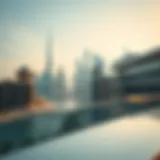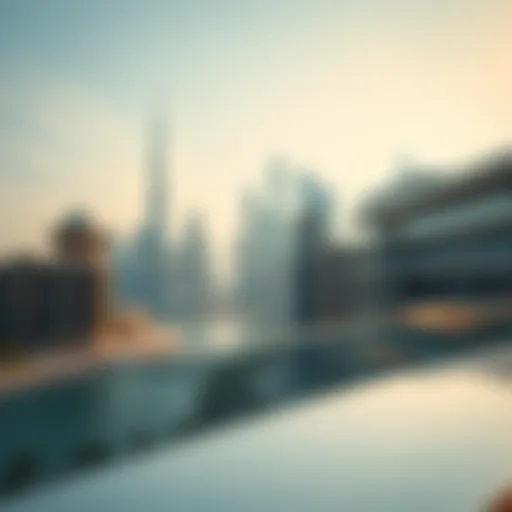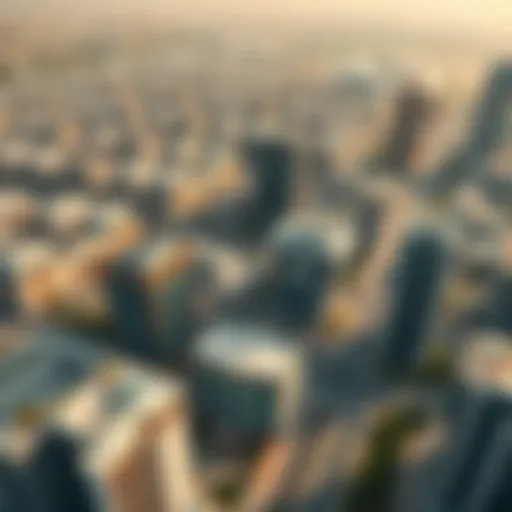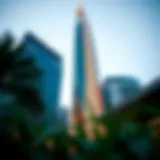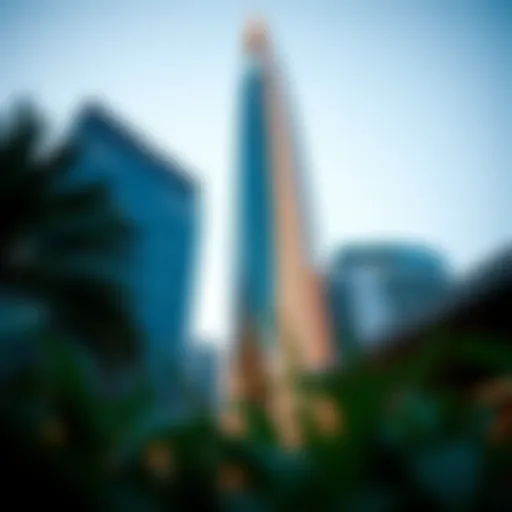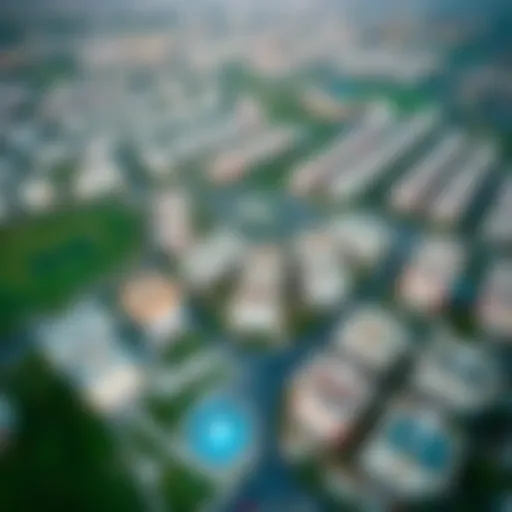Dubai's Real Estate: Understanding Boulevard Dynamics


Intro
In the heart of Dubai’s architectural marvel lies a network of boulevards, pulsating with life and opportunity. These grand avenues are more than mere thoroughfares; they are the lifeblood of urban existence, weaving together communities, commerce, and culture. As the city positions itself as a global real estate hub, understanding the significance of these boulevards in property valuation and investment strategy becomes imperative.
The Role of Boulevards
Boulevards in Dubai serve as central axes that influence the dynamics of neighborhoods. Locations like Sheikh Zayed Road and Al Wasl Road are not just significant for their traffic; they are gateways to vibrant lifestyles. The aesthetic design of these boulevards often reflects the character of adjacent neighborhoods, from luxury apartment complexes to bustling retail areas. In this intricate tapestry, community, connectivity, and convenience play pivotal roles, drastically shaping buyer preferences.
Urban Lifestyle
Living on or near these boulevards tends to attract those seeking convenience. The proximity to shopping centers, parks, and public transport makes properties along these paths hot commodities. Potential investors and homebuyers often weigh these factors heavily when making their decisions, as the location speaks volumes about lifestyle opportunities.
As we delve deeper into this article, we will be exploring pivotal market trends, detailed property insights, and the evolving landscape that surrounds these vital conduits of city life.
Understanding Boulevards in Dubai's Urban Planning
Boulevards in Dubai serve as the veins of the urban landscape, facilitating not just transport but also social interactions and economic activities. It’s crucial to grasp their role in urban planning, as they are not merely thoroughfares but critical zones that shape the city’s identity. The concept of boulevards is rooted in historical significance, reflecting changes in architectural styles, planning philosophies, and societal needs. In this article, we delve into the multiple facets of boulevards, examining their historical significance and their role in the holistic development of urban environments.
Historical Context of Dubai's Boulevards
Diving back into the past, the history of Dubai's boulevards is much more than a linear tale. The city's transformation from a modest coastal town to a bustling metropolis has always included revisitng its urban layout. Boulevards found within Dubai were initially designed to facilitate trade and connect resources, echoing the city’s entrepreneurial spirit. As the economy evolved, so did the boulevard's design, driven by a blend of necessity and aesthetic aspirations. By the early 2000s, the approach to boulevards shifted dramatically, focusing on beautification and community engagement, aligning with the Dubai ethos of luxury.
"Boulevards are not just roads; they are the fabric of community life, intertwining paths of history, culture, and economic promise."
Today, boulevards are pivotal in showcasing the architectural prowess of Dubai, adorned with modern marvels like the Burj Khalifa and the Dubai Mall along Sheikh Mohammed bin Rashid Boulevard. The past intertwines with present in these urban paths, offering a reflection of the city’s rich tapestry.
Role of Boulevards in Urban Development
When it comes to urban development, boulevards act as essential catalysts. They are the first impression for newcomers and the sustaining heartbeat for existing residents. Key characteristics such as accessibility, pedestrian-friendly designs, and the integration of green spaces play significant roles here.
- Accessibility: Well-planned boulevards ensure that all areas are within reach, connecting residential neighborhoods with business districts, schools, and recreational spaces. This connectivity enhances livability, making them desirable locations for homeowners and investors.
- Public Spaces: Boulevards often serve as public gathering spaces, providing a venue for social interaction. Cafés, parks, and open-air markets thrive along these routes, creating vibrant environments where community spirit can flourish.
- Aesthetic Appeal: The design of a boulevard significantly befits its use. Architectural trends seen in modern developments highlight a commitment to blending form with function. Through art installations, green corridors, and the incorporation of diverse materials, they add a unique character to their surroundings.
To sum up, understanding boulevards in Dubai involves recognizing their multifaceted impact on urban life. They go beyond being mere conduits for transport; they transform into integral elements that reflect the city’s culture, economic vigor, and community heart.
The Significance of Location
Location is the heartbeat of any real estate investment, and nowhere is this truer than in the vibrant city of Dubai. The significance of location in Dubai's real estate landscape cannot be overstated, especially for buyers, investors, and agents looking to understand the market's pulse. It is not just about where a property sits on a map; it encompasses the access it provides to essential amenities and infrastructure, influencing overall quality of life and property value.
A prime location often translates into high demand, which is essential for capital appreciation. Buyers are increasingly drawn to neighborhoods with vibrant community features, proximity to workspaces, and serene parks. The different facets of location can create a layered perspective on investment strategies.
Proximity to Key Amenities
The appeal of boulevards in Dubai lies partly in their proximity to key amenities. Residents want to live where daily conveniences are a stone's throw away. For instance, take the Boulevard Mohammed bin Rashid. This prominent thoroughfare is dotted with upscale restaurants, shopping malls, private schools, and healthcare facilities. The ease of access to these amenities often becomes a decisive factor for families and individuals alike.
- Shopping: Convenience is king in urban areas like Dubai. With plenty of shopping options along the boulevards, residents can easily indulge in leisure time without straying too far from home.
- Education Facilities: Top-tier schools bolster property desirability. Locations adjacent to reputable institutions tend to see a surge in interest from families prioritizing their children's education.
- Health Services: Proximity to hospitals and clinics enhances peace of mind for families. Properties in locations with easy access to quality healthcare often retain their value more effectively.
In essence, when prospective buyers weigh their options, they often place a premium on living within walking distance of these vital conveniences, shaping their property choices to align with their lifestyle needs.
Accessibility and Transportation Links
Another critical aspect in the tapestry of location is how it connects to transportation networks. In Dubai, accessibility plays a pivotal role in the desirability of residential boulevards. Efficient public transport systems, along with well-maintained roadways, frame the overall experience of urban living.
Imagine living along the iconic Sheikh Mohammed bin Zayed Road, where connectivity reigns supreme. Being close to metro stations and bus stops can greatly influence a buyer’s decision.
- Public Transport: Well-connected neighborhoods provide ease of travel for residents and visitors alike. Areas with metro access often see quicker appreciation in property value, making them a hot favorite for investors.
- Commute Times: As working professionals flock to Dubai, minimizing commute times becomes a priority. Properties located near main highways or dedicated bus lanes can drastically enhance the work-life balance for residents.


Ultimately, the fusion of accessibility and proximity to key amenities cements the idea of location as the cornerstone of real estate investment in Dubai. Buyers who appreciate these factors invariably make informed choices that align with their expectations and needs, contributing to an evolving real estate ecosystem in the vibrant city.
Boulevard Design and Aesthetics
Design and aesthetics are crucial elements influencing not just the visual appeal but also the overall livability of Dubai's boulevards. The manner in which these sprawling pathways are planned and implemented can dictate everything from pedestrian foot traffic to property values. A well-thought-out design fosters a sense of community and invites interaction, making boulevards more than mere roads; they become dynamic spaces that embody the city's spirit.
Architectural Styles and Trends
When it comes to the architectural styles that grace Dubai's boulevards, one can observe a delightful mix of modernity and tradition. Key features of architectural trends in these areas include:
- Modern Minimalism: Clean lines, expansive glass facades, and open spaces characterize many new constructions. This style promotes transparency and light while attracting a contemporary crowd.
- Futuristic Designs: Skyscrapers with unique, unconventional silhouettes dominate the skyline, offering not just homes but exceptional visual experiences. Structures like the Burj Khalifa exemplify what can be achieved when ambition meets creative design.
- Cultural Infusion: Various boulevards pay homage to Dubai's rich past by incorporating Islamic architectural influences such as intricate tile work and arched doorways, lending authenticity to the newer developments.
This varied architectural approach allows the area to maintain its vibrancy while also appealing to a broad spectrum of personal tastes. Consequently, properties along boulevards often fetch higher prices, as prospective buyers are drawn in by their aesthetic allure and architectural prestige.
Green Spaces and Public Areas
Green spaces and public areas play a paramount role in enhancing the quality of life along Dubai's boulevards. These spaces include parks, gardens, and recreational facilities that intersperse the urban landscape, providing a necessary respite from the bustling city life. Key aspects of these green spaces are:
- Ecological Benefits: Planting trees and creating garden spaces not only beautifies the area but also contributes positively to environmental sustainability. Trees provide shade, reduce heat, and enhance air quality, potentially lowering heating and cooling costs for nearby buildings.
- Social Interaction: Parks and plazas serve as gathering points for families and communities. They encourage social activities, fostering a sense of belonging among residents and boosting community engagement.
- Cultural Events: Public areas often host cultural festivals or farmers’ markets, turning them into vibrant hubs of interaction. These events attract both locals and tourists, contributing to the economic vibrancy of the region.
The presence of these thoughtfully integrated green areas not only enhances the aesthetic appeal of boulevards but also significantly influences property values, making areas more desirable and, in turn, promising lucrative returns for investors.
"Boulevard design is more than architecture; it's about crafting an environment that fosters community bonds and promotes sustainable living."
In summary, the design and aesthetics of Dubai’s boulevards are not simply about beautification but encapsulate a vision for urban living that prioritizes both environment and engagement. This holistic approach sets a strong foundation for the future, making these thoroughfares not just thriving avenues but intrinsic parts of Dubai's identity.
Community Living Along Boulevards
The essence of community living along Dubai's boulevards cannot be understated. These lively pathways are more than just routes; they serve as the very veins of urban life, promoting interconnectivity among residents and businesses. A well-designed boulevard fosters a sense of belonging and inclusivity, vital for sustaining vibrant neighborhoods. As numerous studies indicate, the arrangement of residential and commercial spaces significantly impacts social interactions and contributes to a community’s overall livability.
Centrally located boulevards often become focal points where cultural expressions, social activities, and various events converge. This not only enhances the lifestyle of the residents but also attracts tourists, further enhancing the neighborhood’s profile. The appeal of living on or near a boulevard materializes in numerous ways, ranging from improved property values to a heightened quality of life.
Cultural Diversity and Inclusion
Living along Dubai’s boulevards offers an exceptional opportunity for cultural diversity and inclusion. With its rich blend of expatriates and locals, there is a melting pot of traditions, languages, and lifestyles that flourishes in these neighborhoods. Boulevards often serve as gathering spaces, where residents come together to share their cuisines, festivals, and cultural practices. This fosters a greater understanding and appreciation among different communities.
Moreover, programs that promote local arts and community festivals abound on these busy streets, drawing diverse crowds. Such activities not only bring vibrancy but also strengthen community ties, ultimately creating a more cohesive society. As Jacques Delors once said, "A greater investment in culture will yield a stronger social fabric."
Social Dynamics and Community Engagement
The social dynamics within boulevard communities are often characterized by active engagement and participation. Residents living in these lively neighborhoods tend to be more involved in local governance issues. This engagement springs from the fact that they are not just properties on a map—they are homes filled with families who care about their surroundings.
Regular community meetings, events, and social initiatives sprout along these thoroughfares. Residents are often found organizing book clubs, yoga sessions, and cultural discussions, all aimed at engaging members of the community. Such activities enhance neighborly relations and provide a platform for residents to voice their opinions and concerns—a critical factor in influencing local policies.
Key Considerations for Community Living:
- Proximity to Services: Living on a boulevard often means easy access to grocery stores, schools, and healthcare facilities.
- Safety and Security: Well-lit boulevards with pedestrian-friendly designs create safer environments, reducing crime rates.
- Public Interaction Spaces: Parks and recreational areas located along boulevards allow for more spontaneous social interactions.
In summary, the community living aspect along Dubai's boulevards presents a compelling narrative of connectedness, diversity, and engagement, serving as a model for urban design that encourages a social fabric where interaction, inclusivity, and mutual respect thrive.
A thriving community along the boulevards is not merely an ideal; it is attainable through conscious design and active participation.
For further insights on urban living and community dynamics, consider visiting resources like Wikipedia or Britannica.
Impact on Property Values
Understanding the impact of boulevards on property values in Dubai requires a closer look at the interconnections between location, design, and community dynamics. With boulevards serving as vital arteries within urban layouts, they fundamentally influence residential and commercial real estate investments. Property values along these thoroughfares generally exhibit upward trends due to aesthetic appeal, accessibility, and the vibrancy of surrounding neighborhoods.


Market Trends and Valuation Insights
Boulevard areas often align with key market trends that make them particularly attractive for buyers and investors alike. For instance, properties located along Sheikh Zayed Road or Al Wasl Road have showcased a consistent appreciation in value, driven in part by their strategic locations near business hubs and entertainment centers. In recent years, there’s been a noticeable shift towards mixed-use developments, which include residential, commercial, and recreational spaces all within a single development. This ensures that not only is the real estate valuable, but also livable and vibrant.
Considerations when evaluating property values include:
- Market Demand: High demand for properties in boulevard locations can lead to swift appreciation.
- Aesthetic Appeal: Properties with access to well-maintained public spaces, landscaping, and pedestrian-friendly designs often fetch higher prices.
- Economic Indicators: Local economic stability, employment opportunities, and tourism influx are pivotal in determining market valuations.
Relying solely on historical data can be limiting, so investors should blend traditional property valuation methods with insights gained from emerging data trends. Resources like the Land Department of Dubai offer extensive reports and statistics that can provide buyers and sellers with clarity.
Investment Potential in Boulevard Locations
Investing in properties along Dubai's boulevards is often considered a smart move due to their inherent growth potential. Whether it’s high-rise apartments in Dubai Marina or boutique homes in Jumeirah, the investment opportunities are as varied as they are plentiful. One notable aspect is the appeal of these boulevards for expatriates and locals alike. The blend of community, convenience and culture not only enhances desirability but also robustly supports property investment.
"Locations along the major boulevards of Dubai have historically shown resilience during economic downturns, which makes them a safe bet for investors looking to safeguard their portfolios while achieving significant returns."
Key factors to consider when assessing investment potential include:
- Rental Yields: Properties in these areas command higher rental rates, making them lucrative for landlords.
- Development Prospects: Look out for upcoming projects that may change the landscape of property values.
- Cultural Appeal: The cosmopolitan character of boulevard neighborhoods often attracts a diverse range of tenants, enhancing the demand further.
Maintaining a finger on the pulse of market fluctuations is crucial. Tools such as market analysis platforms and real estate forums, like those found on forums on reddit.com, can provide up-to-date information to assist investors in making informed decisions.
Understanding the nuanced impacts of boulevards on property values reveals depths of opportunity for discerning investors and homebuyers. As the real estate landscape continues to evolve, remaining informed and adaptive is key to success in this ever-dynamic market.
Investment Strategies for Buyers
Investing in real estate is hardly ever a one-size-fits-all endeavor, especially in a dynamic market like Dubai, where boulevards serve as pivotal arteries within the urban landscape. Crafting an astute investment strategy is crucial when navigating this bustling market. An effective approach can offer substantial gains and minimize risks, making it an indispensable part of every buyer's journey.
To successfully engage with Dubai's real estate, understanding the unique characteristics of the boulevard framework is essential. These pathways often feature prime localities teeming with amenities, cultural experiences, and a vibrant atmosphere that can seriously boost property values. Moreover, they thrive on the principles of accessibility, dynamic community living, and aesthetic appeal—all critical factors that potential buyers must consider.
Understanding Buyer Motivation
When assessing the motivations behind real estate purchases, it’s vital to dissect what drives buyers. They may not just be looking for a property to call home; sometimes they're chasin' investment opportunities that promise long-term appreciation. Here are some key motivations:
- Lifestyle Choices: Many buyers desire a specific way of living that aligns with the blend of luxury and convenience that boulevards offer. These properties often come with a host of lifestyle amenities—think cafes, parks, and shops on your doorstep.
- Investment Potential: The prospect of robust returns can be tempting. Buyers often look for areas with potential for future development, which boulevards typically guarantee due to their strategic placements.
- Cultural Integration: With Dubai being a melting pot of cultures, many non-residents might invest in real estate to tap into this unique blend of experiences that a well-placed boulevard can provide.
- Status Symbol: Owning property in a sought-after boulevard isn’t just for comfortable living; it can be seen as a testament to one’s success.
Diving into the buyer's psyche allows agents and investors to tailor their offerings accordingly. Understanding these motivations can lead to effective pitch strategies that resonate more profoundly with prospective buyers.
Evaluating Return on Investment
When it comes to evaluating the expected return on investment (ROI), buyers should focus on several compelling factors. Calculating ROI isn't as straightforward as looking at the price per square foot—it's more about comprehensively understanding the market dynamics and the inherent qualities of the property.
- Location Benefits: As mentioned earlier, boulevards often boast proximity to vital amenities, which can indicate robust demand. Monitoring traffic trends and demographic shifts can provide key insights into future value increases.
- Market Conditions: Understanding current market trends is essential. For instance, if Dubai's property market is experiencing a buyer's craze along specific boulevards, it might be worth getting in before prices skyrocket.
- Rental Demand: If the property is intended for leasing, evaluating rental trends and occupancy rates in boulevard areas gives insight into the cash flow potential. High demand often translates to stronger rental yields.
- Property Developments: Staying informed about upcoming projects can significantly impact future values. If a major new mall or a transportation hub is planned nearby, that's typically a green light on the investment horizon.
- Market Volatility: Understanding the cyclical nature of the property market means buyers must gauge the current economic environment. Are there signs of recession, or is the local economy booming? Investors should be cautious yet decisive in their strategies.
By leveraging these insights, buyers can make informed decisions that not only safeguard their investments but also position them for potential windfalls.
"The best time to plant a tree was twenty years ago. The second best time is now." — Chinese Proverb
In summary, investment strategies for buyers diving into Dubai's boulevards must be holistic, considering both emotional and financial angles. By unraveling buyer motivations and closely evaluating ROI, one can navigate this intricate real estate landscape with foresight and precision.
Challenges and Considerations
The realm of Dubai's real estate, especially with a focus on boulevards, comes with its own set of challenges and considerations that both investors and homebuyers need to meticulously evaluate. While boulevards represent aesthetic charm and strategic locations, the surrounding complexities may pose hurdles. Understanding these elements is crucial for making sound investment choices.
Regulatory Framework and Policies
Dubai’s regulatory landscape is as meticulous as the city itself. The laws governing real estate transactions can seem like a labyrinth to the uninitiated. Each boulevard may have its unique set of guidelines, influenced by both local and federal laws. Notably, the Dubai Land Department oversees the property registration system and ensures that transactions are legitimate, transparent, and secure.


When considering a purchase, it’s vital to be aware of:
- Ownership Laws: Understand whether the property can be owned freehold or leasehold, especially if you’re a foreign investor. In some areas, only locals can own the land, while expatriates can only lease it.
- Approval Processes: Familiarize yourself with approvals from the Real Estate Regulatory Agency (RERA). Closing a deal can sometimes be delayed due to the need for documentation, such as a title deed or land department approvals.
- Fees and Taxes: Awareness of the associated fees plays a significant role in understanding the total cost of ownership. This includes transfer fees, maintenance fees, and service charges.
Staying updated with changes in policies is crucial. Regulations can shift in response to economic pressures or government initiatives aimed at stimulating investment. Always consult with local real estate experts or legal advisors for the latest insights and practical guidance.
Market Volatility and Economic Factors
The market in Dubai can swing like a pendulum, undergoing unpredictable changes based on economic conditions, both domestic and global. Factors impacting real estate activity include fluctuations in oil prices, trade availability, and tourism revenue. When oil prices cratered, for instance, property demand experienced a swift contraction, reshaping the investment landscape along the city’s boulevards.
Some pivotal elements to keep in mind regarding market volatility include:
- External Economic Indicators: Global market trends can significantly affect Dubai’s economy. Events like political instability or changes in international trade can ripple through to the local real estate sector.
- Supply and Demand Dynamics: An oversupply of properties can lead to reduced prices while an uptick in population can spur demand, pushing prices up. Dubai’s boulevards, with their high visibility and accessibility, can see these changes more intensely.
- Interest Rates and Financing Options: Rising interest rates can dampen buyer capacity, reducing the number of transactions. Potential buyers should assess their financing options and be prepared for fluctuations in loan rates.
"Market sentiments can change on a dime, and being prepared for these changes can save investors from big losses."
Investors and homebuyers must conduct thorough market research and reflect on their financial endurance. Keeping an eye on economic indicators and understanding the broader market conditions will help in navigating the uncertainties surrounding Dubai’s boulevards. Being informed ensures that decisions are both strategic and forward-looking.
Future Prospects for Boulevard Development
As Dubai continues to evolve at breakneck speed, the significance of its boulevards in the urban landscape cannot be overstated. Future prospects for boulevard development in the emirate provide a glimpse into the architectural, economic, and social possibilities that lie ahead for both residents and investors. In the context of this article, examining the intricate elements of forthcoming changes brings to light the many benefits and considerations associated with investing in these dynamic areas of growth.
Boulevards are more than just thoroughfares; they are fundamental to urban identity. They shape the character of neighborhoods, making them quintessentially vibrant with life. Prospective developments will harness this potential by ensuring that boulevards not only serve as connectivity routes but also become spaces for leisure, social interaction, and commerce.
Emerging Neighborhoods and Trends
One of the most exciting aspects of future boulevard development is the emergence of new neighborhoods that capitalize on the unique characteristics of these spaces. Areas like Dubai Hills and Dubai Creek Harbour illustrate how urban planning is embracing not just residential needs but also integrating retail and recreational spaces, all while ensuring close proximity to major transportation hubs.
As a result, buyers are increasingly looking at boulevards that promise a blend of convenience and lifestyle. Emerging trends underscore priorities that cater to a multi-functional urban experience:
- Mixed-use developments are becoming commonplace, integrating homes, offices, and shops into cohesive environments.
- Smart city initiatives drive the adoption of technology in public spaces, enhancing both safety and sustainability.
- Walkability is becoming a priority; boulevards that encourage foot traffic tend to foster a sense of community and are often favored by buyers.
Urban planners are further recognizing the influence of cultural and social dynamics in shaping these neighborhoods. Crafting spaces that cater to diverse demographics, including families and expatriates, is essential in enticing a wide range of investors.
Sustainable Development Initiatives
In line with global sustainability trends, future boulevard projects in Dubai is anticipated to see an increasing focus on eco-friendly practices. The push for sustainable development in urban boulevards not only addresses environmental concerns but also improves the quality of life for residents.
Key sustainable initiatives expected in upcoming boulevard developments include:
- Green architecture that minimizes energy consumption. This forms the backbone of several projects, blurring the lines between urban living and nature.
- Sustainable transport solutions, such as dedicated cycling paths and enhanced public transport options, facilitate eco-conscious movement.
- Public green spaces, which are pivotal in fostering community engagement, would be incorporated to promote recreation and relaxation amidst the urban sprawl.
"Sustainability is not merely a buzzword; it's a guiding principle that shapes the future of urban development, ensuring that growth does not come at the expense of our environment."
These initiatives are not only beneficial from a community engagement perspective but also enhance property values. Investors who identify with these prospects are likely to find lucrative opportunities in the evolving landscape of Dubai's boulevards.
The End: The Evolution of Dubai's Boulevards
As we draw the curtain on our exploration into Dubai's boulevards, it becomes clear that these thoroughfares hold much more than mere physical pathways; they embody the spirit of the city's journey through urban metamorphosis. From their nascent stages, evolving from dusty roads into bustling arteries of economy and culture, the boulevards act as a testament to Dubai's ambitious approach to urban planning.
Reflecting on the Changing Landscape
Each boulevard in Dubai tells a unique tale, reflective of both the rapid growth of the city and its cultural tapestry. As housing trends shift and demographics reshape, the landscapes of these boulevards transform correspondingly. For instance, the merge of traditional architectural influences with contemporary design is prominent, found in areas like the Al Wasl Road and Shaikh Zayed Road. Streets once frequented by locals now attract international tourists and business folk, carving out a hybrid environment.
This integral shift has seen a rise in vibrant public spaces, art installations, and community events that seek to engage residents and visitors alike. The adoption of sustainable practices is another noteworthy evolution; more boulevards are now lined with green parks, making them not only easy on the eyes but also promoting a healthier urban lifestyle. By investing in these scenic routes, Dubai sends a clear message that it values livability as much as growth.
"Boulevards are no longer just roads; they are the lifeblood of the community, bridging gaps and cultivating connections in a rapidly modernizing Dubai."
Encouraging Responsible Investments
With the evolution of Dubai's boulevards closely tied to property dynamics, it is crucial for potential investors and homeowners to navigate this landscape with discernment. The proliferation of high-end developments juxtaposed against more affordable housing options means there is something for everyone. However, understanding the nuances of each location is key to making informed decisions.
Investors should pay attention not only to market trends but also to the facilities and attractions that surround these boulevards. A thorough grasp of community characteristics, future development plans, and the socio-economic dynamics of specific neighborhoods can lead to more strategic investments. Moreover, as urban spaces continue to evolve, so too should the investment strategies, ensuring they align with visions for sustainable urban living.
